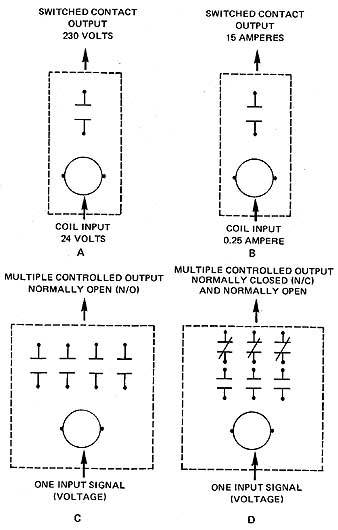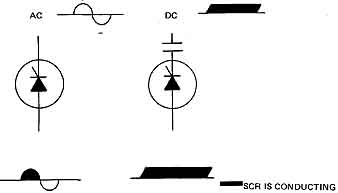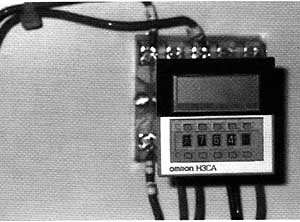AMAZON multi-meters discounts AMAZON oscilloscope discounts
OBJECTIVES
• explain how relays operate.
• list the principal uses of relays.
• describe different relay control and load conditions.
• tell how SCRs operate.
• identify relay component symbols.
• connect different relays in a circuit.
• identify and use various timers.
• use proper timer symbols in schematic diagrams.
RELAYS
Relays are devices used to relay or multiply electrical contact closures. The relay concept is used where a small voltage at low current is used to operate a set of electrical contacts to an open or closed position. This contact operation in turn controls a larger electric load and so on, as it relays the electrical operations.
Another common use of a relay is to multiply a single signal to open or close multiple contacts for control of multiple electrical loads.
ELECTROMECHANICAL RELAYS
Electromechanical relays, contactors, and motor starters basically operate by the same principles. These electrically-operated switches respond to the electromagnetic attraction of an energized coil of wire in an iron core. The devices differ in the amount of current that each must switch. The relay—which can be compared to an amplifier—is used to switch small amounts of currents (usually 0—15 amperes) in many control circuits (ill. 1). Uses of relays include: switching (on and off) larger coils of motor starters, contactors, solenoids, heating elements, and small motors. Other uses are alarm systems and pilot light control. Relays have many industrial and commercial applications, both ac and dc.

ill. 1 Control relay and associated coil contact diagram.
A small current flow and /or low voltage applied to a relay coil can result in a much larger current or voltage being switched. One input signal (voltage) may control several output (switched) circuits.

ill. 2 Several electrical-mechanical relay uses and contact configurations:
SWITCHED CONTACT OUTPUT 230 VOLTS; COIL INPUT 24 VOLTS A; MULTIPLE CONTROLLED
OUTPUT NORMALLY OPEN (N/O); ONE INPUT SIGNAL (VOLTAGE). SWITCHED CONTACT
OUTPUT 15 AMPERES; COIL INPUT 0.25 AMPERE; MULTIPLE CONTROLLED OUTPUT NORMALLY
CLOSED (N/C) AND NORMALLY OPEN; ONE INPUT SIGNAL (VOLTAGE).
The coil voltages of the relay are separate or different from those at the switched contacts; this is called separate control. However, the coil voltage may be the same sys tem voltage as the switched voltage.
Relays are available in many shapes and sizes. Some are sealed in dustproof, transparent plastic enclosures (ill. 3 A). The general construction of a typical relay is illustrated in 3B.
Note in ill. 2 that relay contacts maybe normally-closed or normally-open. The action of the contacts is to switch something on or off depending on the configuration.

ill. 3A “Ice cube relays” and plug in bases used for easy replacement

ill. 3B Construction of a typical electromagnetic control relay: ELECTROMAGNETIC
COIL OF MANY TURNS OF WIRE; TO CONTROL CIRCUIT VOLTAGE; MOVEABLE ARMATURE;
TO SWITCHED LOAD AND VOLTAGE; TO CONTROL CIRCUIT VOLTAGE

ill. 4 Schematic symbol for an SCR which is the heart of the solid-state
relay: SWITCHED POWER TERMINALS; GATE (CONTROL), CATHODE, ANODE
SOLID STATE RELAY (SSR)
A solid state relay can be used to control most of the circuits that the electromechanical relay controls. By comparison, the solid-state relay has no coil or contacts. The semi conductor industry has developed solid-state components with unusual applications to the industrial control processes. These components are very compact and versatile. They are very reliable if used in the proper application.
The silicon-controlled rectifier (SCR) is probably the most popular solid-state device for controlling large and small electrical power loads. Basically, the SCR is a rectifier which either conducts or does not conduct an electric current. When it's not con ducting, the SCR offers almost a complete blockage to the current. It passes only a few milli-amperes to the load. For this reason, some manufacturers place contacts from electrically operated contactors in the total circuit to disconnect the load completely.
The SCR won't conduct when the voltage across it's in the reverse direction. It will conduct only in the forward direction when the proper signal (voltage) is applied to the gate terminal (ill. 4). Once it's conducting, the SCR cannot be turned off immediately. It is necessary only to provide a small signal to start the SCR conducting a current. It will continue to conduct even without a signal from that point on as long as the current is in the forward direction. The only way to stop the SCR from conducting is to reduce the current flow below the holding current level, or disconnect it from the system. On alternating current, of course, this happens every half-cycle, so this characteristic is no problem (ill. 5). For direct-current applications, the voltage is reduced to zero by interrupting the circuit, generally with a contact on an electromagnetic relay.
ill 6 shows a typical solid-state relay. Note the input and switched output terminal connections. ill 7 shows these connections completed. Terminal wiring is very simple and consists of two input control wires and two output load wires. The connecting terminals are clearly identified on solid-state relays (as they are on electromechanical relays). The relay in ill. 7 has a light-emitting diode (LED) connected to the input or control voltage. When the input voltage turns the LED on, a photo-detector connected to the gate of the triac turns the triac on and connects the load to the line. This optical coupling is commonly used with solid-state relays. These relays are referred to as being opto-isolated. This means that the load side of the relay is optically isolated from the control side of the relay. The control medium is a light beam. No voltage spikes or electrical noise produced on the load side of the relay are therefore transmitted to the control side.

ill. 5 An SCR will contact current in the forward direction until
the voltage is reduced to zero.

ill. 6 Solid state relay has no moving parts.
Solid state relays have a wide range of input or control voltage designs. The solid state relays may operate at TTL (transistor logic levels) + 5 volts dc. They may operate at levels between 3—30V dc or other relays at 90—120V ac. Considerations as to what style of relay include the way that the SSR turn on. A zero switch relay turns on as the load volt age crosses zero. This is often used for resistive type loads.
Instant-on relays turn on anytime during the ac waveform to the load. A third style is the universal switch. This turn-on occurs after the load voltage has reached peak and is moving toward zero. The universal switch is used for combination loads of inductive and resistive loads.
TIMERS
Timers come in many different styles and with different operating characteristics. The mechanical timers use either clock motors to operate a mechanical trip mechanism or solenoids to create timing operations. Pneumatic timers use air, a diaphragm, and an operating solenoid to cause a time delay. ill 8 shows a mechanical time-clock-type timer. This type of timer is used for rough time-of-day timing to turn lights or equipment on or off at an approximate time of day. Tabs on the face of the clock are moved to create different on and off periods.

ill. 7 Solid state relay used to control an ac load

ill. 8 Synchronous clock timer
Pneumatic timers such as those in ill. 9 are typically used for on or off delay operations. The symbols illustrated in 10 depict the type of timer operation and the operation of the contacts. In ON-delay timers (TDE, Time-Delay-on-Energization) the contacts stay in their original position until a solenoid plunger has moved through its entire travel distance. The travel time is controlled by adjusting a needle valve to allow the air to escape in front of the solenoid diaphragm. The timer solenoid has power applied to pull the plunger into its timed-out position. The contacts can start as either normally-open or normally-closed and will change to the opposite position at the end of the time, if power is still applied to the solenoid coil.
The OFF-delay timer (TDD, Time-Delay-on-De-energization) acts in the opposite mode. In other words, the timing change to the contacts takes place when the power is removed from the timer coil and the solenoid plunge is allowed to go back to it de-energized position. The time that it takes the solenoid to return to it original position is con trolled by the needle valve allowing air to return to the vacuum side of the air diaphragm. ill 10 shows the TDD contacts in their normal, timed-out state. When power is applied to the timing coil in this type timer, the contacts change to the opposite state and will time out to return to the original designation.

ill. 9 Time delay relay symbols used with timers:.
ill. 10 Time delay on de-energization contact symbols: NORMALLY CLOSED/OPEN, TIME OPENING

ill. 11 Electronic timers with side range of functions and time delays
Solid state timers are now commonly used to provide highly accurate and an extremely wide range of timing operations. Many of the timers, such as the one in ill. 11, can be used as ON-delays or OFF-delays and have several different trigger modes.
They can also provide a wide range of timing, from milliseconds to hundreds of hours.
The timing is accomplished with electronics, which makes them very accurate and precise.
SUMMARY
Relays are used to control various loads from other electrical circuits. They may be used to operate large values of dc or ac power or simply multiply the electrical circuit function. Contacts can be normally-open (NO) or normally-closed (NC) or convertible from one form to another.
Things to consider when ordering:
Control voltage and value;
Contact ratings in current and voltage, number of contacts, NO, NC, or SPDT, etc.
Are open contacts, enclosed contacts, or solid-state no-contact movement important?
Does the relay need very fast speed as in SSR or is physical isolation more important as in electromechanical relays?
QUIZ
1. A mouse trap may be compared with the gate trigger action of an SCR. Indicate whether this statement is true or false and explain your reasoning.
2. What is the major difference between an electromechanical relay and a solid-state relay?
3. Describe different relay control and load conditions.
4. How are relays used in industrial controls?.
5. Basically, what is an SCR?